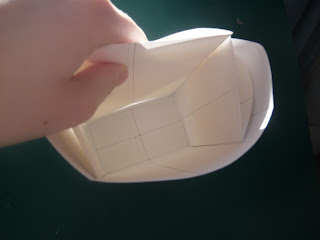I have started to develop my final package design. I am going for a basic prism design with a window. This package will then fall out into a flat circle or square and present a pop-out layout. It is quite difficult to design this package in an easy way so its not too complicated for the user/audience to understand. Below are a few 3D models I have tried and designed myself in order to find a suitable net for the packaging.
Here is one model and I used a circle shape and tried folding it into a prism. I feel that this example has too many folds in it and wouldn't be very aesthetically pleasing as an audience would see the folds before they see the designs.
This is the net I drew out to attempt folding. This is just a practice and I wasn't too
sure what the outcome would be. I began to just draw the shape of the net itself so I knew it would fit into the box. The next step would be the folding.
This is the circle box folded into the prism. I feel that this doesn't fold very well as the folds are in random places. The circle does not fold well.
This inside of the net.
The back of that same net. This shape doesn't fold and hold its shape, it needed my hand to keep it closed. If I wanted to use this net again I would need to put it inside another prism and it would be pulled out by the user/audience.
The net with fold lines. This design is better than the top one as there less folds in it, however the folds aren't int he correct places to enable a neat placing inside the net itself.
Another attempt to designing a box that will fold out flat by using folds at the side that could press together when inside the package and then fold out flat.
Another angle of the net above.
After doing these nets I feel I have got a better idea of how to make my net that folds out but with these trial and errors I have found that I need to do more trials to find a good design that works for both me and the user/audience.


















































